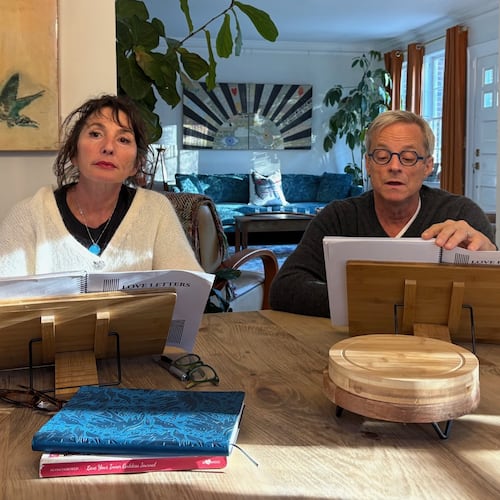A double-entendre title that references the annual start of the school year, “Class Pictures” at the Zuckerman Museum of Art is also about social class and how portraiture can affirm or comment upon it.
Curated by Teresa Bramlette Reeves, the show is notable for the interesting way it mixes six historic figurative works in the Zuckerman collection with contemporary art by a cast of local artists in work that illustrates how subtly and definitively we talk about who we are — or at least what we want to be — in oil paintings or photographs of ourselves.
Alongside Donald Robson’s comically mordant portraits based on model railroad figures, some of the funniest portraits in the mix are Aubrey Longley-Cook’s renderings of Atlanta drag queens with cheeky names like Brigitte Bidet and Dax Exclamation Point in the grandmotherly form of cross stitch. Executed in cheerful, colorful gelato hues, the works are irreverent but also sweet; summoning up the usual craft sentimentality of lots and lots of love expressed in hours hunched over an embroidery hoop.
Longley-Cook’s work is placed next to a more traditional 19th-century portrait from the Zuckerman archives, of an unidentified man in formal dress. Look closely and you’ll see his hairstyle and dandyish garments mark him as a performer as well. In fact, we all perform our own ideas of how we want to be seen when we have our portrait painted or taken, and that juxtaposition of drag queen and flamboyant regular guy nicely teases that point out.
There are a host of other telling mashups made in “Class Pictures.” An especially interesting connection is made between contemporary Atlanta artist Yanique Norman and painter and a co-founder of New York’s Metropolitan Museum of Art, Eastman Johnson. His 19th-century oil painting of his well-married daughter is contrasted with Norman’s meditation on similarly well-married types: American first ladies.
Expanding her visual signature in an exciting new way, Norman makes her own statement about idealized womanhood and power by taking color images of first ladies from Pat Nixon to Melania Trump and replacing their heads with snakelike, kaleidoscopic cut paper collages composed of tiny African-American faces. Billowing up above the first ladies’ heads like plumes of smoke, these unsettling apparitions suggest some denied, unrepresented reality emerging from a superficial American history in a return of the repressed.
In a class by themselves, Paul Stephen Benjamin’s “Flow” series of black-on-black photographs are hauntingly beautiful investigations of what we see and choose not to see in the world. Working on fields of enveloping black, it is not until you are standing directly in front of Benjamin’s photographs that you see the young black men hidden within their depths in powerful, masterfully executed investigations of how we deny or avoid the humanity of some people.
Curator Sarah Higgins’ “Figure Forward” offers another meditation on the figure featuring three Atlanta artists, Jill Frank, William Downs and Jaime Bull, who offer significant departures from how the female form has traditionally been represented in art. Uproarious, campy and loads of fun, Bull’s best pieces are treatises on that most pathos-laden, contentious garment: the swimsuit. In Bull’s wacky soft sculptures, she stuffs enormous (to indicate their outsize role in women’s lives) swimsuits with plastic bags to animate them.
With their often prickly, unexpected vision, Downs’ drawings of women encircled by barbed wire or photographer Frank’s photographs of self-possessed young women (and men) bathing at water’s edge also offer a different view of female muses who have often been stripped of power when they pose for paintings or photographs.
ART REVIEW
“Class Pictures” and “Figure Forward”
Through Dec. 21. 10 a.m.-5 p.m. Tuesdays-Saturdays; noon-5 p.m. Sundays. Free. Bernard A. Zuckerman Museum of Art, 492 Prillaman Way, Kennesaw. 470-578-3223, zuckerman.kennesaw.edu.
Bottom line: Two smart shows about the multiple ways portraits convey meaning at the Zuckerman Museum of Art.
IN OTHER NEWS:
About the Author
Keep Reading
The Latest
Featured





